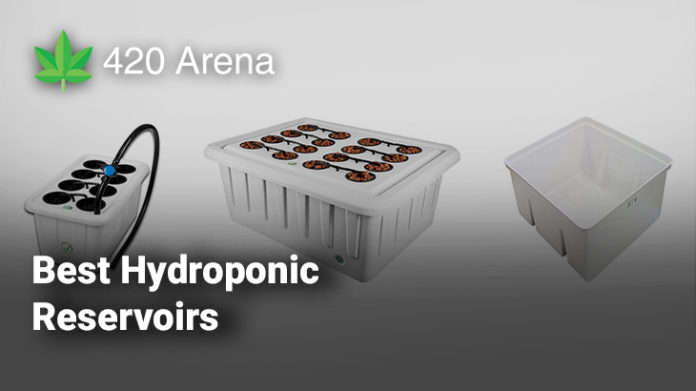Marijuana can be obtained in many ways, some people like to get it from hush hush dealers, others like to get it from their friends, most people tend to go through licensed pharmacies and clinics. However, the best kind of weed is the one that you grow at home yourself. Now, this grow-your-own weed too can exist in multiple types – it can be grown outdoors, indoors or it can be grown hydroponically. Hydroponics has been catching on with a number of growers, especially those living in regions where the soil isn’t so fertile or in places where they are short of space.
Over the course of this article, we shall be taking a closer and detailed look at hydroponics and how you can grow your weed using the labour of water. We shall specifically be talking about the 3 best hydroponic reservoirs in 2020 and review them for you so that you know which is the right option for you. Buying hydroponic reservoirs can be quite a challenging task especially because there are just so many different types of hydroponic setups involved.
In this guide about the 3 best hydroponic reservoirs in 2020, we shall be discussing the different hydroponic systems before we review the different options you have for buying reservoirs. We have gone through several reservoirs before finalizing on these ones and these are the best and the most high-quality options that you can buy in the markets today. Before that, however, let us take a look at what hydroponics is and how it is different from traditional soil-based growing:
Hydroponics vs Soil Based Growing: What is Hydroponics?
Weed can be grown in many different ways but two of the most important ways are using either soil as a medium or by using water as a medium. A medium is basically the surface via which nutrients and water is provided to the plants. In case of a traditional soil-based growth, you would normally pour a solution of water and nutrients on to the soil which will eventually get absorbed by the plants. However, in a hydroponic setup, the water is directly provided to the roots via different methods.
‘Hydroponic’ growth literally consists of ‘hydros’ and ‘ponos’ which basically means the labour of water. Hydroponic growth allows you to reuse the same water and nutrient solution for a longer time – thereby saving quite a bit of water. Also depending on the setup that you are using you might actually be saving a lot of space as well. Furthermore, using a hydroponic setup saves you from several soil-borne diseases that are otherwise a problem. The biggest advantage is that you get bigger plants and that the plants grow faster because of direct access of water and nutrients to the roots. It is also good for the health of your roots as they do not have to stress themselves out to seek the water and nutrients from the soil.
What is a Hydroponic Reservoir?
No matter what kind of a hydroponic setup you are going to use, practically all of them need to have a ‘reservoir’ from where water will flow into the rest of the setup. This is a critical part of hydroponic growth and can be of different shapes and sizes depending on the setup. However, it is fundamentally a storage unit where water mixed with nutrients is stored and from where it circulates into the entire system and ultimately reaches back here.
It looks very ordinary but it is a very important part of a hydroponic setup as even a slight leak in the reservoir could affect the whole system. It is the base which tends to support some systems as well! Reservoirs also tend to house the airstones, which help to oxygenate the water, as well as submersible pumps which help power the water through the entire system! All of this put together makes it an integral organ of your hydroponic system and you must make sure it is of the best quality!
Different Kinds of Hydroponic Setups
Let us now take a closer look at some of the different kinds of hydroponic setups that are out there. These are critical to know as your reservoir location determines a lot about the way your plants grow:
- Ebb and Flow Hydroponic Setup
The ebb and flow system of hydroponic growth is one of the most popular setups around the world. Here, you have the reservoir below your plants. Your plants are kept on a tray which drips into the reservoir. The tray is provided water multiple times a day to an extent that it floods and the water then drips down into the reservoir from where it can be reused.
- Water Culture Hydroponic Setup
This is the most basic and entry-level setup where growers allow their plants to hang above the reservoir with their roots directly in contact with the reservoir. This is a good setup for those growers who aren’t really used to hydroponics but want to try out the ropes.
- Nutrient Film Technology (NFT) Hydroponic Setup
This process involves water from a reservoir (which can be placed anywhere) passing through a film of nutrition and reaching the plants, from where it is drained back into the reservoir. While this setup might be a little different but the basic mechanics of the Nutrient Film Technology setup is quite similar to what we have seen in the Ebb and Flow system of hydroponic growth above.
- Drip or Top Feeding Hydroponic Setup
Here, the nutrient and the water go separately with the help of drip pipes and emitters. The reservoir is generally kept below the plants from where the water is pumped out and where it flows back in to be re-used. This is also a very popular setup for growers.
The 3 Best Hydroponic Reservoirs in 2020
No products found.
1. Superponics-8 Hydroponic Reservoir System
No products found.
For those growing marijuana indoors in a hydroponic setup, this is a great reservoir to start off with. The manufacturer claims that plants which are grown using this reservoir can grow up to 5 times faster. This is a reservoir which functions on the top feeding and drip system where the water and nutrients are provided via the top feeding mechanism while oxygenation happens with the bottom-feed. Put together, this is a great tank for your plants.
This is an entire hydroponic system in itself where you can grow up to 8 plants at a time. This is great because everything’s just at one place and if you are someone who is just starting off with hydroponic growth this is something you should totally be looking at. To fine-tune the system, you also get a timer using which you can customize when the watering should happen! There are 8 built-in slots for 8 plants, each of which is 3” in size giving you enough space for your plants. Overall, it can support 132 gallons of water per hour.
Check Price & Reviews on Amazon
2. Botanicare 707155 reservoir, 40 Gallon
No products found.
A 40-gallon reservoir from Botanicare which helps ensure that your plants never fall short of water when growing on a hydroponic setup! This looks like practically any other reservoir at first glance but a closer look at the details will tell you that it is quite different. This is made out of BPA-free materials which means it is completely safe to use and non-toxic, furthermore, another noticeable thing about this reservoir is that it is made out 70% recycled plastic. This is among the best hydroponic reservoirs in 2020 if you are someone who is just starting off with hydroponic growth.
It has all the slots needed to accommodate devices such as pumps, etc. This reservoir from Botanicare weighs in at 11 pounds and measures in at 38.75″ x 34.75″ x 12.25″ which is a decent size for most growers. One disadvantage of buying this reservoir is that the lid has to be purchased separately which is quite inconvenient for buyers and sometimes the lid and the reservoir come separately which is also quite strange. Nonetheless a great option for those with basic needs.
Check Price & Reviews on Amazon
3. Superponics-16 Hydroponic Plant Propagation Reservoir System
No products found.
Yet another product from Superponics, but this time bigger than what we had seen above. This is a 16-plant system, double the size of the previous one. Functionally it is exactly the same as the previous one – as it offers a similar drip and top feeding system where oxygen is provided at the bottom while the nutrients and the water are fed to the plant using the drip tubes on top. There are 16 cups here for 16 plants, each one measuring in at 3 inches which is good for most growers’ needs.
Again, the simplicity of the system stands out as it is very easy to use as well as very easy to maintain. Thanks to the double systems that it functions on, even if one of the two stops working the other will sustain the growth while you fix it. One major highlight of this system, which truly makes it among the best hydroponic reservoirs in 2020 is the fact that it comes with a silent-functioning Eco Series air pump, which ensures that enough oxygen is provided to the plants via the oxygenated water. The pump can provide about 185 gallons of water per hour to the system.
Check Price & Reviews on Amazon
Buyer’s Guide: Things You Must Consider When Buying a Hydroponic Reservoir in 2020
There are many options in the markets but which is the best hydroponic reservoir for your which matches all your needs? Here’s a quick checklist you can go through before you make a final purchase.
-
Size of the Tank
Size of the tank is very important – you need to know the exact length, breadth, and height of the tank to know how much water it can hold. You must also ensure you are checking out the inside dimensions and not just the outside dimensions because the outside dimensions usually tend to be bigger. How many gallons of water you can hold is important for your growing operation – you need a bigger tank if you are growing a larger number of plants and a smaller tank will do for lesser plants.
-
Material Used
The best hydroponic reservoirs in 2020 are made out of recycled and BPA free materials which ensures that these are environment friendly and will not cause any toxicity. Most tanks these days are made out of these kinds of materials which are quite plant-friendly. Make sure you are getting the right kind of material else you might risk a negative impact on your plants.
-
Kind of System You Have
Your reservoir needs to match the hydroponic system that you are using. In many cases you will find the entire setup attached to the reservoir so that won’t really be a problem. However, there shouldn’t be a mismatch between the reservoir your get and the system you are using.
-
Number of Plants You Are Going to Grow
Simple math says the more the number of plants you are going to grow, the larger the reservoir that you are going to need. Keep this in mind when buying a reservoir. Considering that most reservoirs offer you an entire hydroponic system built on to them, you will know how many plants you can grow using it.
-
Maintenance
Lastly, you need to make sure that the reservoir you are buying is going to be easy to maintain and clean. All your accessories such as the pump, airestone, and other equipment need to fit in properly. Cleaning is also quite important and must be user-friendly. Here’s a detailed look at cleaning your reservoir:
How to Keep Your Hydroponic Reservoir Clean?
The best hydroponic reservoirs in 2020 are those which can be easily cleaned. Cleaning a reservoir can often be quite a challenge, especially for new growers who aren’t familiar with the setup. A number of pathogens such as bacteria and fungi can grow in a reservoir if it is not cleaned properly and at regular intervals. Here are some tips which will help you keep the reservoir clean:
- Make sure you are changing your water frequently. Most growers do it once every three to four days, while some even go to a maximum of a week. Do not keep water for over 7 days in any circumstances. If you throw away the water too early that won’t be an effective use of the nutrients you have added to the water but if you throw it too late you might risk bacteria or fungi growing in the reservoir.
- Once you toss out the water in your reservoir, always make sure that you are cleaning the inner walls properly before you fill in freshwater because sometimes organisms which breed in water tend to develop and stick around in the walls. We also suggest cleaning of filters and air stones.
- Using filtered water in your hydroponic reservoir is another great way to make sure your plants are getting the best and the cleanest kind of water. Reverse Osmosis (RO) filters are great for this. The best practice is to use RO water and to clear out the tank every week and clean it. When these two things are done together, there’s very little chance of a bacterial or a fungal infection ever happening to your setup.
Frequently Asked Questions (FAQs) About Hydroponic Reservoirs
Here are the answers to some of the most common questions that growers ask when it comes to setting up a hydroponic system for growing plants.
1. What is the role played by a hydroponic reservoir in the overall setup?
The most fundamental function of a hydroponic reservoir is to store water and nutrients and ensure that they stay in a place from where they can be provided to the plants and the excess amount can be drained back to the reservoir for being re-used. Reservoirs also act as a container to prepare the nutrient solution in just the right mix. They are also the space where oxygenation is possible helping the plants get better water.
2. What is the ideal temperature of the water?
When it comes to nutrient solutions and their efficiency to be maintained, you would require the water in your reservoir to be at a stable temperature. Between 65 to 80F is ideal for the growth and development of your plants.
3. What do I need to run the reservoir smoothly?
Apart from the plants (obviously), you will need a pump to power the water through the tubes that will be attached to your pump. This pump can be either a regular pump which will have to be placed outside the reservoir or a submersible pump which can be placed in the water. Moreover, you would need a fair bit of tubing connecting through the pumps to the overall system and from the plants back to the reservoir as well. Airstones would also be needed to oxygenate the water.
Conclusion
We hope that by this point in the article you have a fair understanding of what hydroponic reservoirs are and why do you need them. We have also provided a list of the three best hydroponic reservoirs which you can buy off the web right away and start using them in your hydroponic setup! We have also provided a buyer’s guide for a better understanding of our readers. Do let us know over the mail or drop a comment if you still have any more questions about these reservoirs and we shall get back to you immediately! Till then..
…Happy Growing! 🙂
Table of Contents


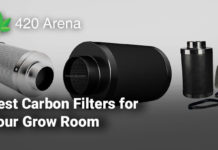
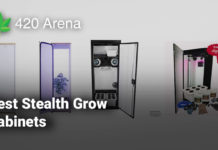





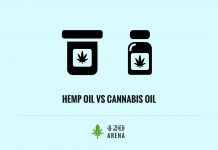



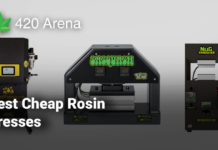


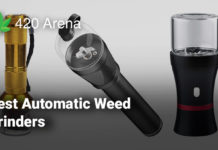
![How to Use Carbon Filters in Your Grow Room [7 Best Carbon Filters for Grow Rooms in 2021] How to Use Carbon Filters in Your Grow Room](https://420arena.com/wp-content/uploads/2020/12/How-to-Use-Carbon-Filters-in-Your-Grow-Room-218x150.jpg)





